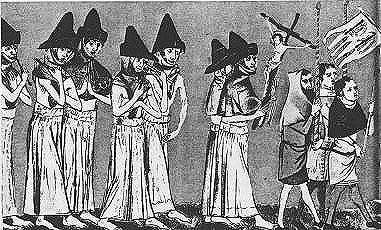Thursday Sept. 16: Medieval Witches: the Plague and the Death Obsession
To view the powerpoint overheads, click here:
class notes main page
Thursday Sept. 16: Medieval Witches: the Plague and the Death Obsession
To view the powerpoint overheads, click here:
I. Black Plague a. Time Period
a. Time Period-Plagues racking Europe throughout middle ages, but the Black Death or Black Plague generally refers to:
-1347 -beginning of the Black Plague.-it is marked by widespread afflictions in unprecedented numbers
b. Scope of Damage
No concept of contagion and no understanding of germs meant little in the way of treatment or containment.
-Mortality rates: minimum 1/5 of population died in some areas, maximum 9/10ths to 100% of population died in others. Overall, roughly 1/3 of Europe's entire population died.
-In 5 years (1347-52), 25 million people died
-Monasteries and convents, because closed communities, suffered almost 100% fatality rates: led population at large to wonder what humans had done to so anger God.
-Bubonic and Pneumonic Plague
plague begins as a disease spread by contact. Quickly transforms into more virulent form- airborn disease-no concept of germs, so little in way of explaining contagion
-humours and astrology: two theoretical schemes appealed to for diagnosis and cure
In world where unseen supernatural forces are at work, there was no incentive to appeal to more anatomical or biological accounts of illness.

c. Social Disruption-The plague contributed to social anxiety and fear of death, also economic stress and breakdown of social cohesion
-Boccaccio wrote: "[The plague] chilled the hearts of men"
-people began to distrust others, including family members. Sought solitude, in order to avoid the plague
-people sought scapegoats - the attacks on Jewish and Leper communities of this period seem to speak for the fear wracking people of this time
-killed rich, poor, ugly, beautiful, clerical and lay people. For this reason, it seemed that everyone,regardless how pure or seemingly blessed, was subject not only to God's wrath, but to the pain and decay of mortality

- Increased Fear of Satan-either God punishing humans or a great evil was at work in the world
-the late middle ages marked by an increasing fear of evil at work in the world. The plague arguably exacerbates this fear.
-Flagellants

atonement for sins of humanity. Denigration of flesh as means to spiritual transcendence
II. The Death Obsession
a. Causeslife is short and marked by pain and decay of death-people died at home, amongst family.
-Easy to imagine an obsession with mortality when whole households falling ill, and survivors left to bury the dead
-no privacy in this period - people lived, ate, and slept all in one room, extended families the norm
-there were no hospitals so people suffered and died in the home
-these facts important for understanding the full impact of the plague
b. Death and the Maiden
-the idea that the most pure person, the virginal young woman (or maiden) was no less subject to the ravages of death was a strangely common theme in art of the Plague period
c. Dance of Death
We looked at Hans Holbein's work. click here to see more slides:
Dance of Death Images depicting death leading away its victims was a common artistic theme of the period
d. Relation to Witchcraze
the church's inability to stem tide of plague, the fact that church itself was not immune to this great evil, cements fear that evil is at work,that Satan a force to be reckoned with-arguably this creates popular support for the witchcraft persecutions being carried out by Church at this time
-as well, the growing fear of outsiders and misfits in this once tolerant society gets directed towards the village witch, healer, or any suspicious beggar passing through
-so, we see in this chapter of Klaits's, the roots of witchcraze in the Church's war on heresy as well as in the post-Plague popular mentality